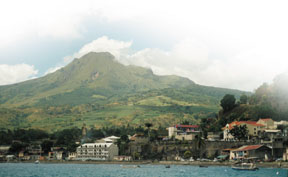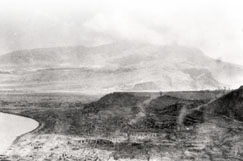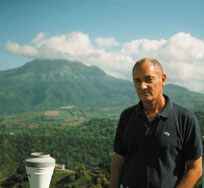
The politicians had an election coming up on May 11, 1902, and the threat of an actual eruption was a secondary concern for the heads of the predominately white conservative ruling party. Elected senator in 1899, socialist Amédee Knight, a black man educated in Paris, gave voice to Martinique’s racial majority of blacks and mixed-race French citizens. To the minister of colonies in Paris, the possible socialist party gains in the 1902 election posed a greater threat than Pelée.
Mount Pelée rises over the harbor city of St. Pierre in Northwestern Martinique. Today's modern buildings rest on the charred remains of the earlier foundation. Ruins serve as the city's prime tourist attractions. Photo by Christina Reed
The majority of the conservative voters lived 6 kilometers south of the volcano in St. Pierre. The modern French scholar Solange Contour wrote in 1989 that the minister of colonies in Paris ordered Governor Louis Mouttet to keep the citizens of St. Pierre in the city until after the election.
But for many weeks prior to the election, the volcano warned of its choked-up nature, and a few hundred prescient residents who could afford to travel left anyway. Pelée had gurgled to life earlier in the year, spitting a rain of ash and burping sulfuric gases over its neighboring towns to the point where horses were reported collapsing in the streets from asphyxiation.
On April 23, the Étang-Sec, or dry pond crater, exploded. An investigation party climbed the volcano on April 27 and saw water again pooled in the crater and the emergence of a growing ash cone. The governor set up a commission of inquiry to study the volcano’s activity.
On May 5, water heated from fumarolic activity burst through the rim of the crater wall. The escaping lahar pummeled its way down the valley of the Blanche River, killing 23 workers in a rum distillery. Despite this activity, the commission deemed Pelée did not warrant a departure from St. Pierre. The editor of the local paper Les Colonies supported this decision, touting the city as safe. Indeed thousands of people from neighboring ash-deluged towns sought refuge at St. Pierre, exploding the population to about 28,000. To reassure the populace, the governor and his wife returned to St. Pierre from Fort-de-France on May 7.
On the morning of Thursday, May 8, 1902, the bells of the cathedral in St. Pierre rang out. Rum ships as usual waited in the harbor. But this being Ascension Day, many of the Roman Catholic merchants — instead of trading their usual fares of liquor, sugar cane, fish and spices — were in the cathedral praying for deliverance from the volcano. Indeed, because of the ash, general sickness and despair pervaded the city, and most of the shops had been closed for days.
Shortly before 8 a.m. on May 8, witnesses such as Roger Arnoux, a member of the Astronomical Society of France who was located safely out of reach of the volcano, reported hearing a tremendous explosion from Pelée and seeing a dark cloud traveling swiftly up and out from the crater, hugging the ground on a path toward St. Pierre.
 The nuée
ardente overwhelmed St. Pierre, melting the master cathedral bell into a crumpled
mass and setting fire to the ships in the harbor. Only two men walked away from
the scorched city, their skin burned but their clothes intact — the hot
cloud of ash had passed too quickly for the fabric to ignite. Historical accounts
report that the cobbler Leon Compère-Léandre, 28, was sitting
outside on his doorstep when the peripheral of the nuée ardente passed
through the neighborhood. He ran inside to seek shelter, his legs and arms burning.
Others who had been walking along the street quickly followed him. While Compère-Léandre
escaped suffocating on the ash, those people only a few feet away from him when
the cloud hit did not.
The nuée
ardente overwhelmed St. Pierre, melting the master cathedral bell into a crumpled
mass and setting fire to the ships in the harbor. Only two men walked away from
the scorched city, their skin burned but their clothes intact — the hot
cloud of ash had passed too quickly for the fabric to ignite. Historical accounts
report that the cobbler Leon Compère-Léandre, 28, was sitting
outside on his doorstep when the peripheral of the nuée ardente passed
through the neighborhood. He ran inside to seek shelter, his legs and arms burning.
Others who had been walking along the street quickly followed him. While Compère-Léandre
escaped suffocating on the ash, those people only a few feet away from him when
the cloud hit did not. On May 8, 1902, Pelée erupted with a catastrophic nuée ardente, or glowing avalanche, scorching the city of St. Pierre, 6 kilometers southwest of the volcano. On May 20, another eruption again covered the city. Isreal Cook Russell took this photo facing northeast, looking over the devastated St. Pierre from the slope of Morne d'Orange on May 22, 1902. Archival Photo #904, courtesy of the USGS.
The second survivor, 25 year-old Auguste Ciparis, had been imprisoned in a small stone jail. While the cloud passed over the prison, cooking the interior like a kelm, the poor ventilation protected Ciparis from breathing the searing ash. After the eruption he sustained himself on a small bowl of water for three days until visitors searching the grounds heard his cries. Subsequently pardoned, “the prisoner of St. Pierre” spent the rest of his life displaying his scars in the Barnum and Bailey Circus.

 Today Jean-Pierre
Viode and his team at the Observatoire Volcanologique de la Montagne Pelée
monitor the volcano from 8 kilometers away. “Building an observatory at
the top of a volcano is not such a good idea,” remarks electronic engineer
Patrick Tuchais. Radio waves connect the scientists to the instruments on Pelée’s
summit and flanks. They use a variety of seismic sensors, tiltmeters measuring
ground deformation and magnetic field sensors, and keep both paper and computer
records of the information they gather. Only a few volcanic earthquakes shake
the island each year, but should Pelée awaken, “the Volcanic Observatory
can see new activity months before an eruption,” Viode says. He finds life
on the island “very exciting, for a volcanologist.”
Today Jean-Pierre
Viode and his team at the Observatoire Volcanologique de la Montagne Pelée
monitor the volcano from 8 kilometers away. “Building an observatory at
the top of a volcano is not such a good idea,” remarks electronic engineer
Patrick Tuchais. Radio waves connect the scientists to the instruments on Pelée’s
summit and flanks. They use a variety of seismic sensors, tiltmeters measuring
ground deformation and magnetic field sensors, and keep both paper and computer
records of the information they gather. Only a few volcanic earthquakes shake
the island each year, but should Pelée awaken, “the Volcanic Observatory
can see new activity months before an eruption,” Viode says. He finds life
on the island “very exciting, for a volcanologist.” 